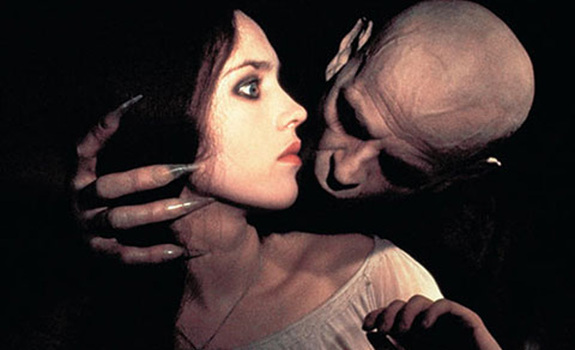
When Werner Herzog remade F.W. Murnau’s masterpiece in 1979 with Klaus Kinski in the titular role he essentially bridged the gap between pre-Nazi German cinema and the determinedly nationalistic New German Cinema. By remaking Murnau Herzog realizes this historic continuity as it was suggested and later confirmed by renowned critic Lotte Eisner. This not only posits that Herzog is some sort of heir to the cinematic traditions of Murnau, but that the state controlled cinema of Nazi Germany was and is not a part of German cinema as a whole.
Interestingly Herzog’s primary aesthetic concerns in his film Nosferatu The Vampyre are wholly at odds with Murnau’s Nosferatu (1922). The Murnau of 1922 was entirely immersed in expressionism, imbuing every shot in his film with symbols hidden within a larger dynamic composition. In fact, Herzog’s version is more akin to Murnau’s latter career after he emigrated to the United States to work at Fox. If one looks at the privilege that Murnau’s camera gives to environment, space, and nature in Tabu: A Story Of The South Seas (1931) one quickly realizes that Murnau’s approach serves as a kind of blueprint for Herzog’s take on Bram Stoker’s novel.
The old assuage “a place for everything and everything in its place” could well be the guiding principal to Herzog’s use of spaces. Each character has their own space that, when they enter another space, seems quite extraordinary or weird. When Harker (Bruno Ganz) makes his trek to visit the Count he moves from his natural bourgeois setting (where he appears quite at ease) to the vast openness of the mountains and valleys (where he is but a spec in the frame) then only to wind up slightly contorted by the bizarre dressings of the Count’s castle home. Dracula’s journey through space is, of course, the opposite of Harker’s. But Lucy (Isabelle Adjani) manages to be unchanging in her navigation of space and environment.
Sound and montage also work to open up the film. The score by Popol Vuh evokes the ancient and mysterious Europe of folklore while the long takes invite the audience’s eyes to wander and drink up the totality of a single shot. These three tactics that Herzog employs in Nosferatu The Vampyre, though clearly derived in some way from Murnau’s work, have been relatively constant in Herzog’s body of work. What is significant about Nosferatu The Vampyre is that Herzog is making explicit these historic and aesthetic connections; he is remaking Nosferatu in the manner Murnau would have done.
